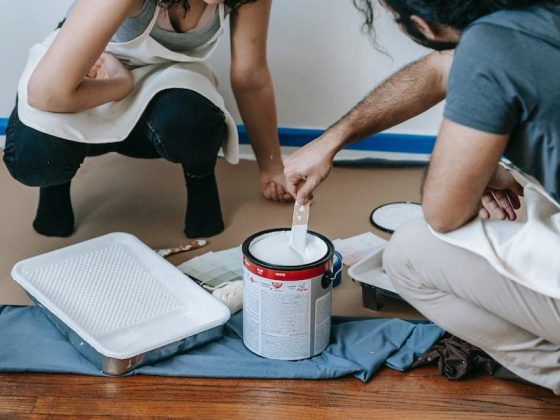All basements are prone to flooding, especially those located in areas with a history of heavy rain or snow melt. It’s a risk you take when building your home below ground level, but it doesn’t mean you need to give up on the idea of having a basement. You just need to know how to stop a flooding basement. This article will give you all the advice and tips on how to stop a flooding basement. We’ll start by looking at the different types of flooding and why they occur. We’ll also explore some common causes of basement floodings, including heavy rain and plumbing leaks from upstairs bathrooms or sinks. Finally, we’ll take a look at the best ways to prevent any unwanted water from ruining your basement and belongings again in the future.
How To Stop A Flooding Basement?
Check the foundation
Before you start repairing a flooding basement, first make sure that the basement isn’t the result of a faulty foundation. If your home is built on a foundation with settling issues, you may have a problem with standing water in the basement at all times, not just during a downpour. If you notice other foundation issues, such as cracks, heaving, or shifting, call a foundation repair company for assistance. On the other hand, if your basement floods only during heavy rains, then you can use these eight steps to stop your basement from flooding.
Install a sump pump
A sump pump is an essential basement water-removal tool. It works by sucking water from a drainage pit on the floor of the basement. It then transports the water to a sump pit and out to the ground outside the house where it belongs. Sump pumps work better than buckets and other crude water removal methods because they don’t risk flooding the house. Sump pumps are available at every hardware store, and contractors also install them as part of larger basement water-removal projects. A sump pump is not an ideal solution, though. It’s expensive to run, it’s noisy, and it requires a significant amount of maintenance. But the benefits are undeniable. If you have a high water table or a quick-draining area, then a sump pump is a must.
Add drainage tiles
If sump pumps aren’t an option for you, then you can try installing drainage tiles. This method is also known as French drains, but the tiles are more permanent and less conspicuous than a French drain. French drains are trenches filled with gravel that transport water from a specific area to the ground outside the house. French drains are great in specific circumstances, but they’re not always effective in certain areas. If you need a long-term solution for keeping your basement dry, drainage tiles are the better option. These tiles are made of perforated, plastic pipes installed in a grid beneath the ground around the house. They allow water to seep through the tiles and into the ground, alleviating pressure on the house.
Install a dehumidifier
Installing a dehumidifier in the basement is an excellent way to help prevent the flooding of your basement. The dehumidifier will suck up the excess moisture in the air and turn it into condensate that can be drained out of the basement. This is a great option if you don’t want to put in any type of permanent or semi-permanent basement water control solution. Many contractors recommend this option if your basement doesn’t flood too often. However, dehumidifiers don’t work if the water table is too high. You’ll want to check the area around your house to determine if this will be an effective solution for your flooding basement.
Seal up cracks and crevices
If you have standing water in parts of your basement that aren’t near a drainage area, you can seal up cracks and crevices in the walls and floors. You can use epoxy or other sealants, or you can install expansion joints in the walls. Build your basement walls from thicker materials than the walls above the basement. Otherwise, basement walls are particularly susceptible to flooding from water seeping in from the ground around the foundation.
What Causes Basement Flooding?
1. Springtime Rain
Spring is the time of year when it rains the most. This is because of snowmelt and warm temperatures. When the snow melts, it seeps into the ground, which can cause your basement to flood if there’s no way for it to drain out. Also, warm temperatures cause water to evaporate faster, which causes water tables to rise and can flood your basement as well.
2. Sump Pumps Don’t Work
If a sump pump breaks or malfunctions, then you’ll have a lot of water in your basement in no time at all. Make sure that your sump pump is working by testing it every once in a while to make sure that it actually pumps out the water instead of just letting it sit there and collect more water until you get home from work or are asleep at night. If you need a new sump pump, contact a professional for help with installation and setup.
3. Groundwater Levels Are High
If groundwater levels are high due to excessive rain or melting snow from earlier this spring, then this will cause groundwater levels to rise and can lead to flooding in your basement or crawl space if there isn’t enough drainage around the structure for all of that water to go somewhere else. If you notice standing moisture in your basement or crawl space when groundwater levels aren’t high, then there may be a problem with drainage around the house.
4. Water Table Is High
If the water table is high, then that means that there’s more water than usual underground. This can lead to flooding in your basement or crawl space if there isn’t any drainage to carry it away from the structure. You can check with your city hall or local building department to see if they have information about whether your area is prone to flooding during certain times of the year, and if so, how much of a problem it can be.
Types Of Basement Flooding
1. Springtime Flooding
If there’s too much water in the ground and it can’t drain away from your house, then it will end up in your basement. Springtime flooding is particularly likely if you live in an area that has a lot of snow or rain.
2. Groundwater Flooding
If the groundwater level is high, then this can lead to flooding from groundwater as well as springtime flooding. This is common if you live in an area with a lot of rain or snowmelt. If the water table rises too high, then it could flood your basement even if there isn’t any excess rain or snowmelt at all.
3. Sump Pump Failure
If a sump pump fails, then water will start to collect around the structure and seep into your basement through cracks and holes where the foundation meets the ground or through vents that are intended to help air flow out of the basement through small holes in the floor or walls. You should test your sump pump every once in a while to make sure that it works correctly and doesn’t break down on you when you need it most.
Tips To Stop A Flooding Basement
1. Check for Leaks
If there’s a leak in your basement or crawl space, then water will seep through and start to collect around the foundation. You can check for leaks by running a garden hose down any drains or vents in your basement, and if you see water flowing out of the drain or vent, then that means there’s a leak and you should contact a plumber to fix it.
2. Call a Professional
If you think your sump pump is broken or not working correctly, then you should call a professional to come to check it out and have it fixed if necessary. You can also hire professionals to check your drainage system and make sure that everything is working correctly so that the water has somewhere else to go besides into your basement.
3. Use a Dehumidifier
If your basement is prone to flooding, then you should use a dehumidifier to prevent water from collecting on the floor and seeping in through cracks and holes in the foundation. A dehumidifier will help to keep the humidity level low, which will prevent water from collecting on the floor.
4. Install Vents and Drains
You can install vents and drains around the perimeter of your basement so that water has somewhere else to go besides into your basement. This is especially important if you live in an area with high groundwater levels or a lot of rain or snowmelt because it will help to prevent flooding even when there’s not much rain or snowmelt at all.
Conclusion
If you want to avoid the hassle and mess of a flooding basement, it’s important to take the proper precautions. By checking your home for signs of water damage, cleaning out your gutters, and keeping your sump pump and water shut-off valves in good working order, you can greatly reduce your risk of basement flooding. Whether it’s from rainwater, plumbing leaks, groundwater, or neighboring property, there are ways to prevent flooding in your home. If you want to avoid the mess and cost of repairing water damage, start by following these tips to stop a flooding basement.










